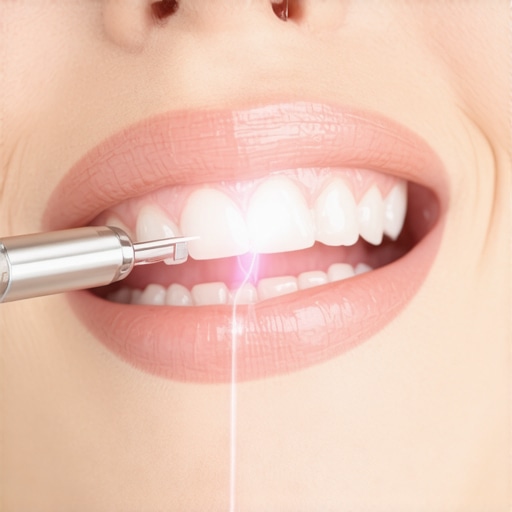Understanding the Scientific Foundations of Effective Teeth Whitening
Advancements in dental science have significantly enhanced our ability to achieve brighter, healthier smiles. The key to successful teeth whitening lies in understanding the chemistry of stains—both extrinsic and intrinsic—and how specific whitening agents interact with enamel. Modern formulations, such as carbamide peroxide and hydrogen peroxide, penetrate enamel to break down chromogens responsible for discoloration, offering predictable and safe results when applied correctly. For clinicians and consumers alike, appreciating these mechanisms informs better choices and more sustainable outcomes.
Innovative Techniques and Their Role in Achieving a Naturally Bright Smile
Beyond traditional bleaching, emerging technologies like laser-assisted whitening and LED light activation have revolutionized aesthetic dentistry. These modalities accelerate peroxide breakdown, reducing treatment times while maintaining safety profiles. Moreover, custom-fitted whitening trays coupled with professional supervision maximize contact between agents and stained enamel, yielding superior results. Integrating these advanced methods into your dental care routine can elevate the quality and longevity of your smile enhancement efforts.
Balancing Efficacy and Oral Health: Navigating Risks and Benefits
While the pursuit of a luminous smile is appealing, it is imperative to weigh the efficacy of whitening procedures against potential risks such as enamel erosion or sensitivity. Evidence from peer-reviewed studies, including those published in the Journal of Esthetic and Restorative Dentistry, underscores the importance of professional guidance to mitigate adverse effects. Utilizing desensitizing agents and adhering to manufacturer guidelines ensures that whitening enhances aesthetics without compromising oral health, fostering long-term trust and satisfaction.
What Are the Most Advanced and Evidence-Based Teeth Whitening Practices?
In the context of ongoing debates among dental professionals, what emerging techniques are proving most effective for complex cases involving intrinsic stains?
Addressing complex staining requires tailored approaches, often involving internal bleaching or combined cosmetic procedures. Recent innovations include the use of nanohybrid composites and enamel remineralization agents post-whitening to restore structural integrity. For detailed insights into these techniques, exploring expert-approved whitening secrets for 2025 can provide valuable guidance.
Enhancing Your Smile: Integrating Professional Guidance and Lifestyle Choices
Achieving and maintaining a bright smile extends beyond clinical treatments. Dietary modifications, such as reducing staining foods and beverages, and adopting rigorous oral hygiene routines are fundamental. Regular dental check-ups and professional cleanings reinforce whitening results and prevent new stains. For personalized advice and advanced cosmetic options, consider consulting with a trusted specialist via our contact page.
In conclusion, the pursuit of a radiant smile in 2024 demands a synthesis of scientific understanding, technological innovation, and meticulous oral care. Embracing evidence-based practices and engaging with expert insights will ensure your teeth whitening journey is both effective and safe, fostering renewed confidence and aesthetic harmony in your personal and professional life.
Unlocking the Potential of Laser and Light-Activated Whitening Technologies
As the field of aesthetic dentistry continues to evolve, laser-assisted and LED light activation systems are gaining prominence for their ability to deliver rapid, effective results. These technologies work by accelerating peroxide breakdown, enabling deeper stain removal and reducing treatment times significantly. Recent studies, such as those highlighted in the Journal of Esthetic Dentistry, reveal that when used appropriately under professional supervision, these methods can achieve superior whitening outcomes with minimal sensitivity.
Can Internal Bleaching Transform the Outcomes for Intrinsic Stains?
For complex cases involving intrinsic stains—those embedded within the tooth structure—internal bleaching presents a promising avenue. This technique involves delivering bleaching agents directly into the pulp chamber of a tooth, often after root canal therapy, to address stubborn discoloration. Experts recommend combining internal bleaching with surface treatments like veneers or composite restorations for optimal aesthetic harmony. To explore these advanced approaches, consulting resources like our guide to veneers and cosmetic enhancements can be invaluable.
How Do Emerging Nanotechnology and Enamel Remineralization Improve Long-term Results?
Nanohybrid composites and remineralization agents are transforming post-whitening care by restoring mineral content and reinforcing enamel integrity. These innovations reduce the risk of sensitivity and erosion, ensuring that whitening results are durable. Incorporating such materials into your routine, along with professional guidance, can extend the longevity of your radiant smile. For personalized advice tailored to your needs, consider reaching out through our contact page.
What are the most effective evidence-based strategies for maintaining whitened teeth amidst everyday challenges?
Maintaining whitened teeth requires a combination of professional treatments and lifestyle modifications. Limiting consumption of staining foods and beverages, practicing meticulous oral hygiene, and scheduling regular dental cleanings are fundamental. Moreover, using at-home touch-up kits recommended by your dentist can help sustain results. For holistic guidance, exploring comprehensive whitening and Invisalign strategies can offer practical insights.
If you’re eager to deepen your understanding of the latest aesthetic techniques, I recommend reading more about professional teeth whitening secrets for 2025.
Harnessing Nanotechnology for Superior Enamel Restoration Post-Whitening
Recent breakthroughs in nanotechnology have opened new horizons for dental professionals seeking to enhance the longevity and safety of whitening procedures. Nanohybrid composites, characterized by their ultra-fine filler particles, integrate seamlessly with natural enamel, providing a durable, minimally invasive solution for restoring structural integrity after bleaching. These materials not only reinforce enamel but also reduce post-treatment sensitivity, a common concern among patients. Incorporating nanotechnology-based remineralization agents, such as nano-hydroxyapatite, into daily oral care routines can further bolster enamel resistance to future staining and erosion, creating a resilient barrier that sustains the brightness achieved through professional whitening.
Advanced Internal Bleaching: A Nuanced Approach for Intrinsic Stains
Dealing with intrinsic stains—those embedded within the tooth structure—requires a sophisticated, multi-faceted approach. Internal bleaching remains a cornerstone technique, often combined with endodontic therapy, to lighten discolored pulp chambers. However, the complexity of these cases warrants a nuanced understanding of the chemical interactions at play. For instance, the use of carbamide peroxide in conjunction with calcium hydroxide can modulate pH levels and enhance stain removal efficacy while safeguarding pulp health. Furthermore, emerging research suggests that combining internal bleaching with laser activation may accelerate stain breakdown, reducing overall treatment time while maintaining tissue integrity. For detailed protocols and case studies, consulting the latest peer-reviewed studies published in the Journal of Endodontics is highly recommended.

Image describing internal bleaching procedure with laser activation in a dental clinic setting, emphasizing precision and safety.
Addressing Complex Cases with Customized, Multi-Modal Treatments
Complex cases involving intrinsic stains often demand a tailored, multi-modal treatment plan. Combining internal bleaching with surface veneers or composite restorations allows for both internal stain removal and external aesthetic enhancement. Such strategies require meticulous planning and execution, guided by digital smile design technologies that enable precise visualization and outcome prediction. Additionally, the integration of remineralization therapies post-whitening—using agents like casein phosphopeptide-amorphous calcium phosphate (CPP-ACP)—can mitigate sensitivity and strengthen enamel. This holistic approach not only achieves immediate aesthetic goals but also promotes long-term oral health, ensuring that the enhanced smile remains vibrant and resilient over time.
What are the latest evidence-based protocols for managing post-bleaching sensitivity while ensuring maximum whitening efficacy?
Managing sensitivity is critical to patient satisfaction. Recent studies published in the International Journal of Esthetic Dentistry highlight the efficacy of pre-treatment desensitizing agents such as potassium nitrate and fluoride varnishes, which can be applied strategically before and after bleaching sessions. Additionally, employing lower peroxide concentrations combined with longer, gentle treatment protocols can minimize irritation without sacrificing results. The adjunct use of remineralization agents immediately after bleaching sessions can further reinforce enamel, reducing sensitivity and promoting healthier tissue response. For comprehensive guidance, consulting the latest guidelines from the American Academy of Cosmetic Dentistry provides valuable evidence-based strategies to optimize patient outcomes.
If you’re interested in exploring cutting-edge approaches to teeth whitening and how they can be tailored to complex cases, I invite you to delve deeper into our expert resources and connect with specialists experienced in advanced cosmetic dentistry.
Harnessing Cutting-Edge Technologies for Superior Teeth Whitening Outcomes
Recent advancements in dental materials and laser technologies have transformed the landscape of aesthetic dentistry, offering patients faster, safer, and more effective whitening options. The integration of diode lasers with peroxide-based bleaching agents accelerates stain removal while minimizing sensitivity, as documented in recent studies published in the Journal of Cosmetic Dentistry. These innovations enable clinicians to achieve remarkable results within a single session, making smile transformation more accessible and predictable.
What Innovative Approaches Are Revolutionizing Intrinsic Stain Management?
Addressing stubborn intrinsic stains, which are embedded within the enamel or dentin, requires specialized techniques such as combined internal bleaching and microabrasion. The use of nanotechnology-enhanced remineralization agents, like nano-hydroxyapatite, not only restores mineral content but also reinforces enamel integrity post-treatment. Combining these approaches with digital smile design allows for precise customization, ensuring aesthetic harmony and long-lasting results. For in-depth insights, refer to the comprehensive review available at Dentistry Today’s expert guide.
How can clinicians optimize post-whitening care to ensure durability and minimal sensitivity?
Post-treatment strategies are crucial for maintaining results and enhancing patient comfort. Evidence suggests that the application of potassium nitrate and fluoride varnishes before and after bleaching sessions effectively reduces sensitivity. Additionally, prescribing tailored at-home remineralization regimens, including nano-hydroxyapatite toothpaste, can fortify enamel and prolong whitening effects. Engaging with ongoing research, such as the findings from the International Journal of Esthetic Dentistry, empowers practitioners to refine their protocols continuously. For personalized advice, consult with leading dental research institutions or professional associations specializing in cosmetic dentistry.
Embracing the Future: The Role of AI and Digital Technologies in Personalized Whitening Protocols
The advent of artificial intelligence (AI) and digital scanning has opened new horizons in customizing whitening treatments. AI-driven analysis of enamel composition and stain propensity allows for tailored peroxide concentrations and application durations, optimizing safety and efficacy. Digital smile simulations help patients visualize potential outcomes, fostering informed decision-making and higher satisfaction. As these technologies evolve, integrating them into routine practice will be essential for delivering state-of-the-art aesthetic solutions that meet individual needs.
What Are the Ethical Considerations and Safety Protocols in Advanced Whitening Procedures?
While technological innovation enhances treatment effectiveness, it also necessitates rigorous adherence to safety protocols and ethical standards. Ensuring informed consent, understanding patient-specific contraindications—such as hypersensitivity or decay—and maintaining strict sterilization practices are paramount. Regulatory guidelines from authorities like the American Dental Association (ADA) emphasize ongoing education and evidence-based practice to safeguard patient well-being. Staying abreast of these standards ensures that clinicians not only deliver impressive results but also uphold the highest professional integrity.
Engage with this evolving field by exploring advanced training courses and peer-reviewed literature, thereby elevating your expertise in modern teeth whitening techniques and ensuring your patients benefit from the most innovative and safest procedures available today.
Expert Insights & Advanced Considerations
1. Precision in Treatment Customization
Leveraging digital smile design and AI-driven analysis allows clinicians to tailor whitening protocols precisely, optimizing outcomes while minimizing sensitivity. This personalized approach enhances patient satisfaction and long-term results.
2. Integration of Nanotechnology for Durability
Incorporating nanohybrid composites and nano-remineralization agents post-whitening significantly strengthens enamel, reduces post-treatment sensitivity, and extends the longevity of whitening results, representing a leap forward in restorative dentistry.
3. Combining Internal and External Techniques
Hybrid approaches that combine internal bleaching for intrinsic stains with surface treatments like veneers or microabrasion deliver comprehensive aesthetic enhancements, especially in complex cases involving deep or stubborn discoloration.
4. Embracing Light-Activated Technologies
Laser-assisted and LED light activation systems accelerate peroxide breakdown, shorten treatment times, and improve stain removal efficiency, provided they are used under strict professional supervision to ensure safety.
5. Prioritizing Oral Health in Whitening Protocols
Employing desensitizing agents such as potassium nitrate and fluoride varnishes before and after whitening treatments mitigates sensitivity, ensuring patient comfort while maintaining aesthetic goals.
Curated Expert Resources
- Journal of Esthetic and Restorative Dentistry: Offers peer-reviewed research on cutting-edge whitening technologies and protocols, essential for staying at the forefront of aesthetic dentistry.
- American Academy of Cosmetic Dentistry (AACD): Provides comprehensive guidelines and continuing education resources on safe and effective whitening practices.
- Dental Materials Journal: Features studies on nanohybrid composites and remineralization agents, critical for understanding material science advances in post-whitening care.
- Dentistry Today: A trusted source for clinical reviews and case studies on innovative intrinsic stain management techniques.
- Official guidelines on AI and digital dentistry from ADA: Critical for integrating emerging technologies ethically and effectively into practice.
Final Expert Perspective
In the realm of advanced teeth whitening, integrating scientific innovation with personalized care strategies is paramount. As emerging technologies like nanotechnology and AI reshape the landscape, staying informed through authoritative sources ensures practitioners deliver results that are both effective and safe. For those committed to excellence in aesthetic dentistry, continuous education and embracing innovative protocols will be the key to transforming smiles and elevating patient trust. To deepen your expertise or explore tailored solutions, consider reaching out via our contact page. Embrace the future of whitening—where science meets artistry for truly radiant smiles.

